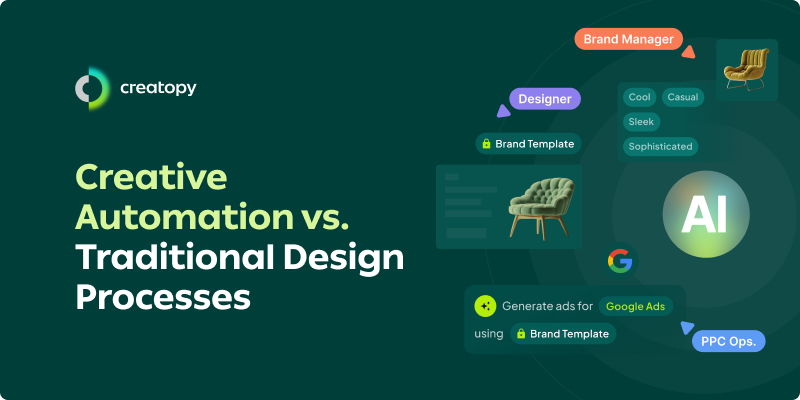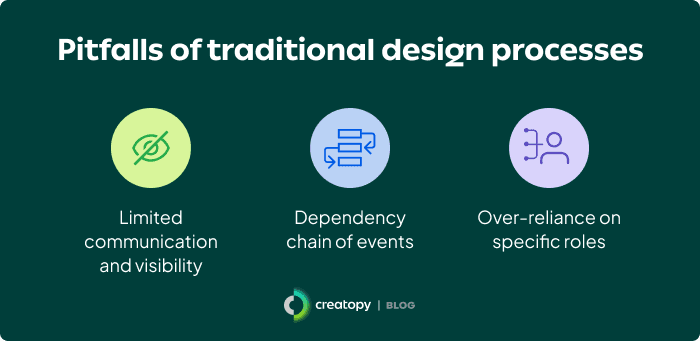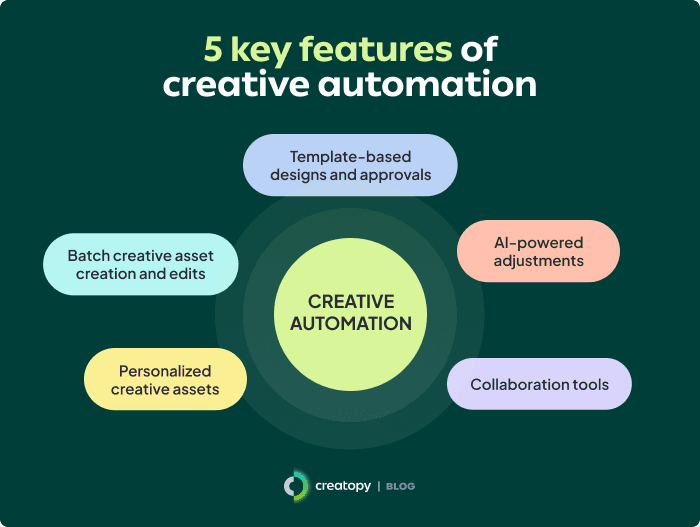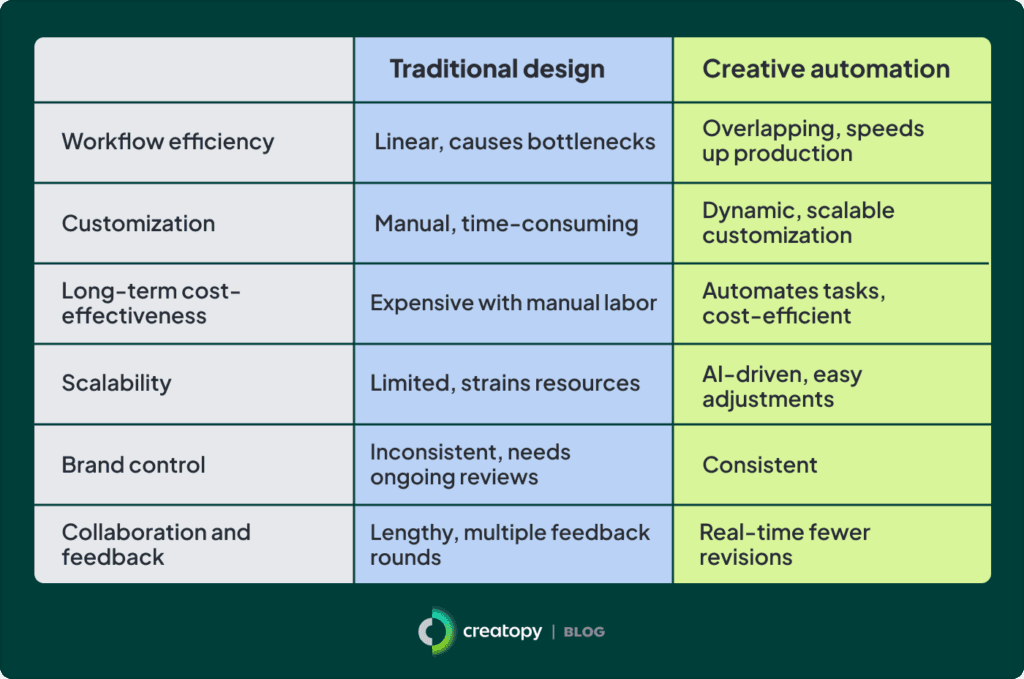Introducing Predictive Scoring, Edit with Prompt, and AI-Powered Resize
The Brief Team
Jul 8, 2025 - 4 min read
Are you an agency? Scale your team's work and impact with The Agency Package.

Traditional design processes have been the norm for designers. Yet, the skyrocketing market demand for visuals is slowly rendering these outdated. It's not only the need for visual marketing assets that increased, but the speed at which they’re being demanded is causing bottlenecks and delays that severely bog down design workflows.
This pressure gave rise to the creative gap. Companies are now struggling to meet the demand for visual content, with 43% of marketers saying that creating consistently high-quality visual assets is one of their biggest challenges.
This calls for a newer approach to traditional design processes—one powered by creative automation.
While we understand that jumping ship to a newer design process involves a lot of consideration, we’d like to walk you through the positive impact of creative automation. To do that, let’s first break down the traditional design process and see where its pitfalls lie.
Traditional design processes are typically carried out manually and require previous steps to be fully completed before designers can move on to the next ones. It involves distinct, blocked design stages consisting of ideation, drafting, design development, feedback, revisions, and asset deployment.
This process’s step-by-step nature means that any design feedback that is received and needs to be implemented requires designers to revisit earlier steps and restart the design workflow yet again. This tends to slow down the design process as a whole.
At a glance, the standard design workflow includes the following steps:
This workflow tends to be repetitive, especially if many revisions are required, or projects call for a high volume of asset variations—as is typically the case with display advertising campaigns.
Companies or agencies working in spaces like e-commerce or travel may feel the brunt of this repetition. They likely need many ad variations, having to consider various ad sizes, formats, and customizations to suit different channels and audiences.
In such cases, the traditional design process tends to fall short, giving rise to several business issues.

The design process is about designing and prototyping and making. When you separate those, I think the final result suffers. —Jony Ive, former Chief Design Officer at Apple
Creative automation adds automation and AI to the traditional design process. This mix of AI and automation reduces the burden of repetitive work while keeping quality and brand-centricity at the core of asset creation. Beyond this, creative automation acts as a blanket layer of connectivity that weaves all phases of the traditional design process together, removing the step-by-step dependencies that overwhelm conventional design processes. These benefits combined are why 50% of social media managers and 40% of paid ad specialists resorted to automation in 2023.
Not sure if creative automation is for you? Check out the five indicators that your business needs creative automation.

As previously mentioned, embedding creative automation into your design process removes the sequential nature of traditional design workflows. Instead, the six steps of the design process overlap and intertwine across the entire workflow.
To exemplify this, let's see how creative automation upgrades the traditional design workflow. To do so, we'll explain how a creative automation tool like The Brief can help you improve your ad design process.
Similar to the traditional design workflows, your creative automation-powered design process may start by clarifying fundamentals: your design’s goals, audiences, and brand guidelines. To do this, designers can use The Brief’s Ad Studio within their “Template Designer” role to set the general creative direction, build Brand Kits, and create reusable, on-brand advertising templates. As part of this, they can leverage advertisement banner templates to maintain consistency across campaigns while streamlining the design process. Additionally, they’d establish permissions for other roles, placing limitations on what creative elements non-designers can change in The Brief and to what extent.
To develop ad designs at scale, non-designers like marketing teams can jump into The Brief’s simplified editor—the Light Editor— as “Content Editors.” In this role, they can generate or edit ads at scale using templates set by designers, with sizing and formatting handled by The Brief’s automation tools. This means they can only tweak ad templates as per the permissions enabled by designers and are barred from playing around with core brand components or layouts.
Regardless of your role in The Brief, The Brief’s AI-driven capabilities and wizards guide users through ad creation with real-time layout, image, and text recommendations. Additionally, The Brief can help you personalize your ad designs with demographic data, CSV files, and other app integrations. These features break down the barriers to ad creation, making it easy for all teams to edit ads without having to consult designers for every change.
Throughout this process, stakeholders can collaborate directly in The Brief using comments, attachments, and tags. These maintain visibility at every level, with no redundant work done due to miscommunications.
Once final approvals are received and ads are launched, The Brief lets you A/B test and update deployed creatives, optimizing them according to incoming data.
Discover the seven The Brief features you can use to make creative automation a breeze for your teams.
Here’s a quick recap of how traditional design processes and creative automation-powered processes differ.

Traditional design processes may have sufficed in the past, but this may not be the case for much longer.
The communication breakdowns, dependency chains, and over-reliance on specific roles that typically plague traditional design processes have dire consequences. Over time, the recurring bottlenecks, expensive delays, and misaligned results these create can wear your design team down and impact quality.
Keeping your design processes in lockstep with market demands involves adopting that much-needed layer of creative automation. Creative automation tools such as The Brief help maximize output by involving both design and non-design teams in asset creation. As a result, you can up your creative productivity and stay true to your brand production without adding pressure on your design team.
7 days free on us
Let's put these insights into action. Build, scale, and automate campaigns with AI-powered workflows.
The Brief Team
Jul 8, 2025 - 4 min read
Derya Yildirim
Feb 21, 2025 - 7 min read